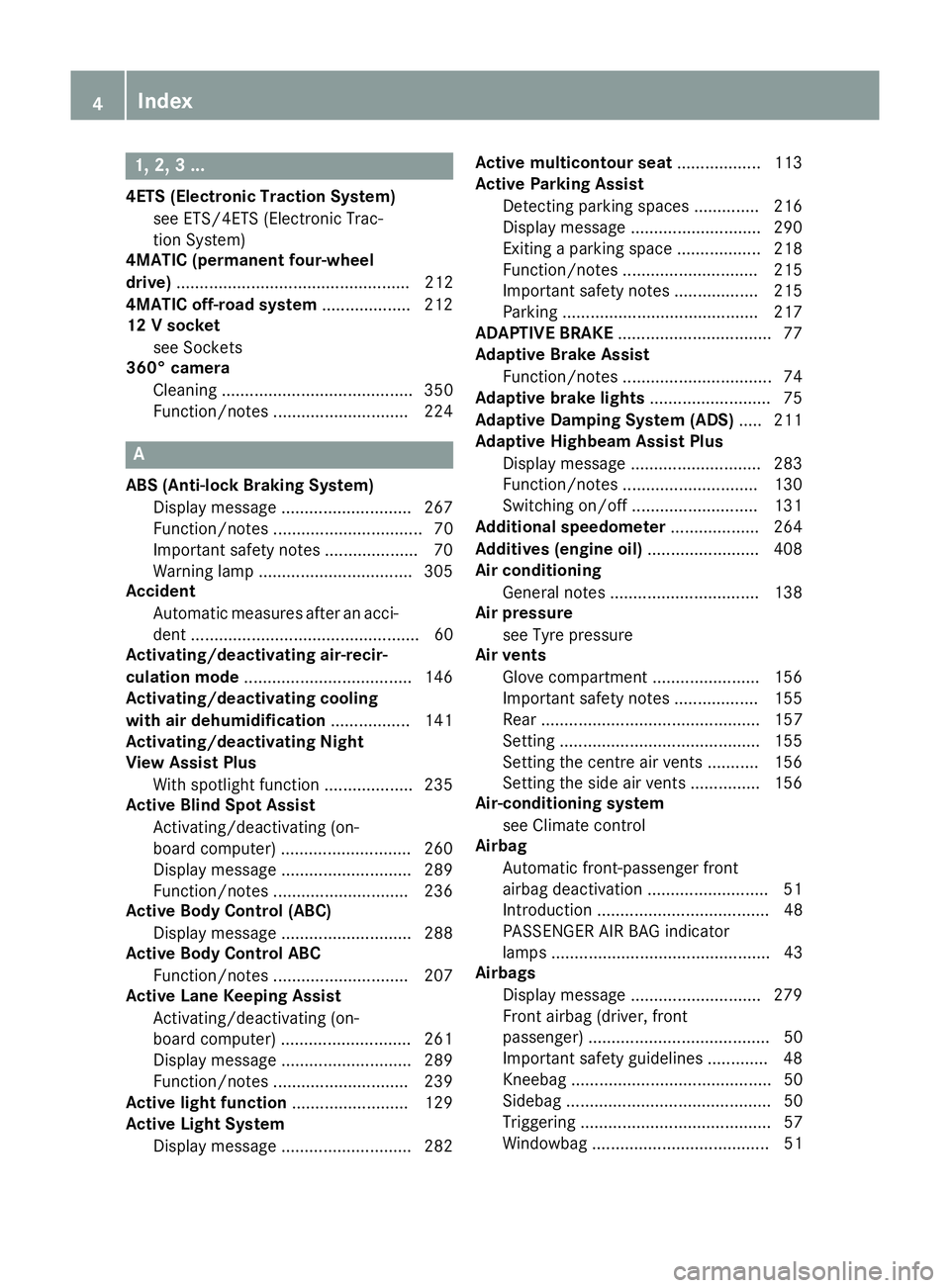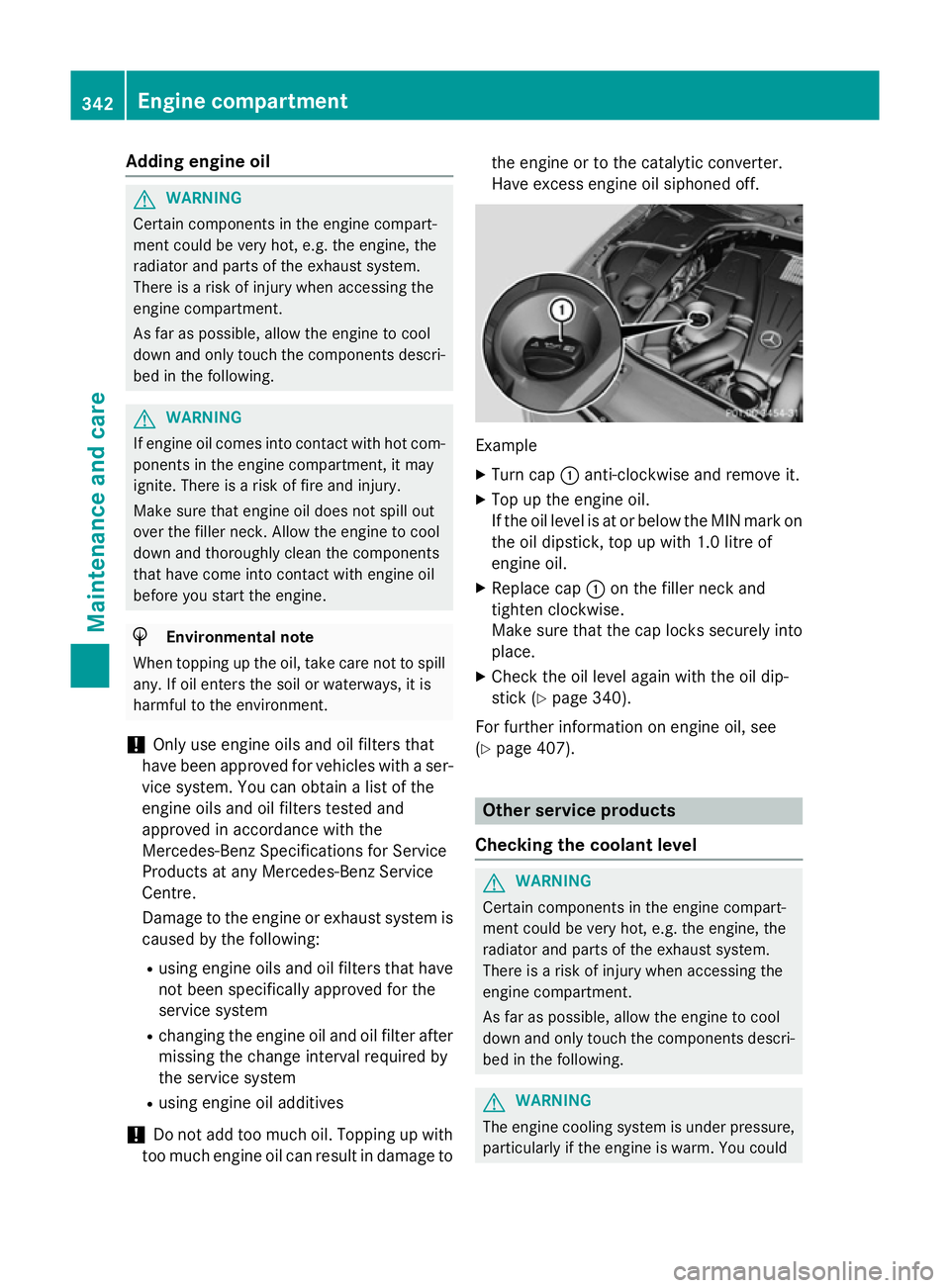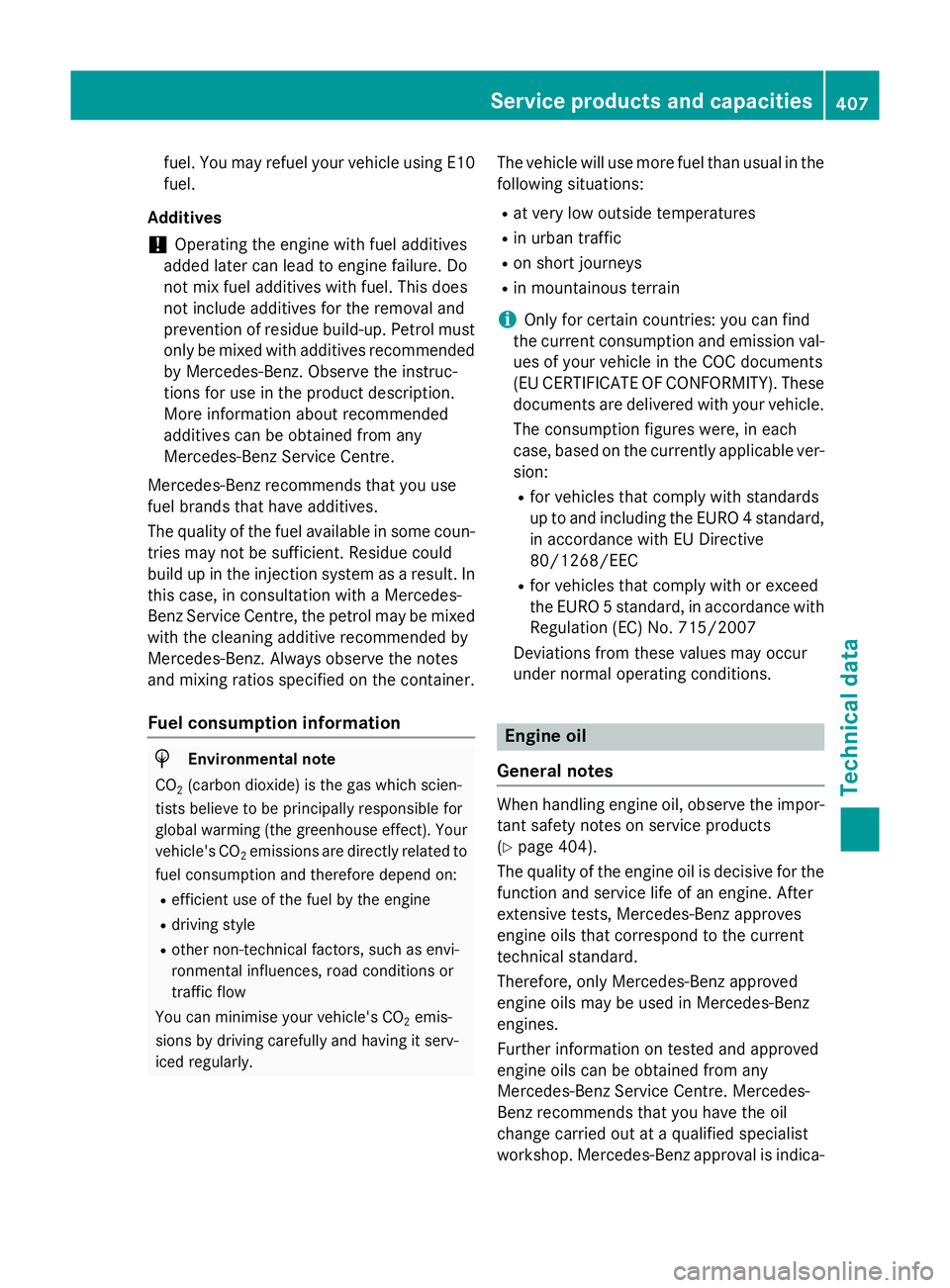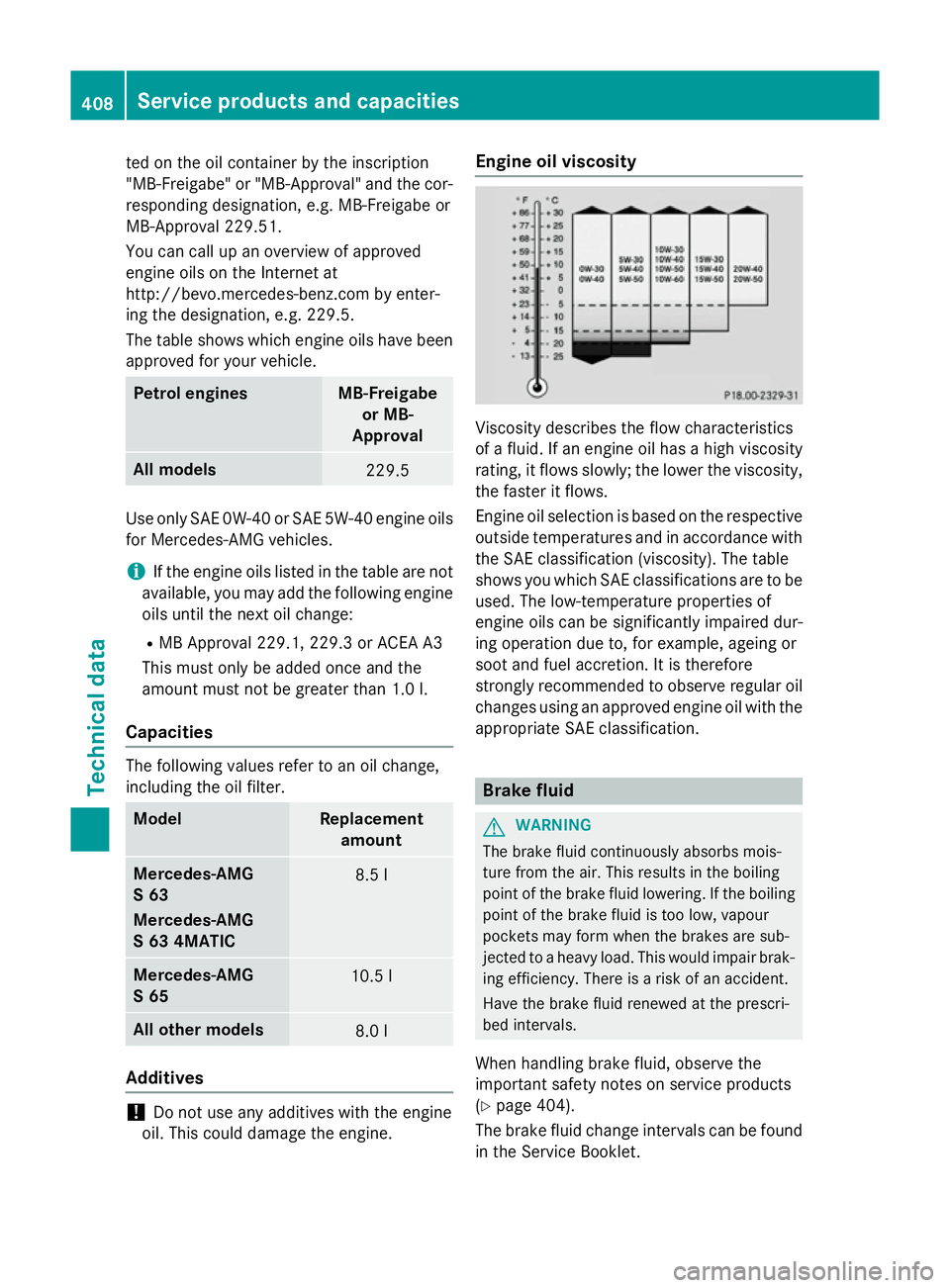2015 MERCEDES-BENZ S-CLASS COUPE oil additives
[x] Cancel search: oil additivesPage 7 of 417

1, 2, 3 ...
4ETS (Electronic Traction System) see ETS/4ETS (Electronic Trac-
tion System)
4MATIC (permanent four-wheel
drive) .................................................. 212
4MATIC off-road system ...................212
12 V socket
see Sockets
360° camera
Cleaning ......................................... 350
Function/notes ............................ .224 A
ABS (Anti-lock Braking System) Display message ............................ 267
Function/notes ................................ 70
Important safety notes .................... 70
Warning lamp ................................. 305
Accident
Automatic measures after an acci-
dent ................................................. 60
Activating/deactivating air-recir-
culation mode ................................... .146
Activating/deactivating cooling
with air dehumidification ................. 141
Activating/deactivating Night
View Assist Plus
With spotlight function ................... 235
Active Blind Spot Assist
Activating/deactivating (on-
board computer) ............................ 260
Display message ............................ 289
Function/notes ............................ .236
Active Body Control (ABC)
Display message ............................ 288
Active Body Control ABC
Function/notes ............................ .207
Active Lane Keeping Assist
Activating/deactivating (on-
board computer) ............................ 261
Display message ............................ 289
Function/notes ............................ .239
Active light function ......................... 129
Active Light System
Display message ............................ 282 Active multicontour seat
.................. 113
Active Parking Assist
Detecting parking spaces .............. 216
Display message ............................ 290
Exiting a parking space .................. 218
Function/notes ............................ .215
Important safety notes .................. 215
Parking .......................................... 217
ADAPTIVE BRAKE ................................. 77
Adaptive Brake Assist
Function/notes ................................ 74
Adaptive brake lights .......................... 75
Adaptive Damping System (ADS) ..... 211
Adaptive Highbeam Assist Plus
Display message ............................ 283
Function/notes ............................ .130
Switching on/off ........................... 131
Additional speedometer ................... 264
Additives (engine oil) ........................ 408
Air conditioning
General notes ................................ 138
Air pressure
see Tyre pressure
Air vents
Glove compartment ....................... 156
Important safety notes .................. 155
Rear ............................................... 157
Setting .......................................... .155
Setting the centre air vents ........... 156
Setting the side air vents .............. .156
Air-conditioning system
see Climate control
Airbag
Automatic front-passenger front
airbag deactivatio n.......................... 51
Introduction ..................................... 48
PASSENGER AIR BAG indicator
lamps ............................................... 43
Airbags
Display message ............................ 279
Front airbag (driver, front
passenger) ....................................... 50
Important safety guidelines ............. 48
Kneebag ........................................... 50
Sidebag ............................................ 50
Triggering ......................................... 57
Windowba g...................................... 51 4
Index
Page 13 of 417

E
EASY-ENTRY see EASY-ENTRY feature
EASY-ENTRY feature
Function/notes ............................ .118
EASY-EXIT feature
Crash-responsive ........................... 119
Function/notes ............................ .118
EBD (electronic brake force distri-
bution)
Display message ............................ 270
Function/notes ................................ 77
ECO display
Function/notes ............................ .185
On-board computer ....................... 250
ECO start/stop function
Automatic engine start .................. 166
Automatic engine switch-off .......... 165
Climate control .............................. 141
Deactivating/activating ................. 166
General information ....................... 165
Important safety notes .................. 165
Introduction ................................... 165
Electromagnetic compatibility
Declaration of conformity ................ 25
Electronic Stability Program
see ESP ®
(Electronic Stability Program)
Emergency
Automatic measures after an acci-
dent ................................................. 60
Emergency key
Unlocking the driver's door .............. 93
Emergency key element
Function/notes ................................ 87
General notes .................................. 87
Inserting .......................................... 87
Locking vehicle ................................ 93
Removing ......................................... 87
Emergency release
Driver's door ................................... .93
Emergency unlocking
Vehicle ............................................ .93
Engine
Display message ............................ 283
ECO start/stop function ................ 165
Engine number .............................. .404
Jump-starting ................................. 366 Running irregularl
y......................... 168
Starting (important safety notes )... 163
Starting problems .......................... 168
Starting the engine with the key .... 163
Starting with the Start/Stop but-
ton ................................................. 164
Stopping ........................................ 182
Switching off with the Start/Stop
button ............................................ 182
Switching off with the vehicle key .. 182
Tow-starting (vehicle) ..................... 372
Warning lamp (engine diagnos-
tics) ............................................... 310
Engine electronics
Notes ............................................. 402
Problem (fault) ............................... 168
Engine oil
Additives ........................................ 408
Checking the oil level ..................... 340
Checking the oil level using the
dipstick .......................................... 340
Checking the oil level using the
on-board computer ........................ 341
Display message ............................ 285
Filling capacity ............................... 408
Notes about oil grade s................... 407
Notes on oil level/consumption .... 340
Temperature (on-board computer,
Mercedes-AMG vehicles) ............... 265
Topping up ..................................... 342
Viscosity ........................................ 408
Environmental protection
Returning an end-of-life vehicle ....... 23
ESP ®
(Electronic Stability Pro-
gram)
Activating/deactivating ................... 76
AMG menu (on-board computer) ... 265
Characteristics ................................. 76
Deactivating/activating ................. 258
Display message ............................ 267
Function/note s................................ 75
General notes .................................. 75
Important safety guidelines ............. 76
Warning lamp ................................. 307
ETS/4ETS (Electronic Traction Sys-
tem) ...................................................... 75
Exhaust
see Exhaust pipe 10
Index
Page 345 of 417

Adding engine oil
G
WARNING
Certain components in the engine compart-
ment could be very hot, e.g. the engine, the
radiator and parts of the exhaust system.
There is a risk of injury when accessing the
engine compartment.
As far as possible, allow the engine to cool
down and only touch the components descri- bed in the following. G
WARNING
If engine oil comes into contact with hot com- ponents in the engine compartment, it may
ignite. There is a risk of fire and injury.
Make sure that engine oil does not spill out
over the filler neck. Allow the engine to cool
down and thoroughly clean the components
that have come into contact with engine oil
before you start the engine. H
Environmental note
When topping up the oil, take care not to spill
any. If oil enters the soil or waterways, it is
harmful to the environment.
! Only use engine oils and oil filters that
have been approved for vehicles with a ser-
vice system. You can obtain a list of the
engine oils and oil filters tested and
approved in accordance with the
Mercedes-Benz Specifications for Service
Products at any Mercedes-Benz Service
Centre.
Damage to the engine or exhaust system is caused by the following:
R using engine oils and oil filters that have
not been specifically approved for the
service system
R changing the engine oil and oil filter after
missing the change interval required by
the service system
R using engine oil additives
! Do not add too much oil. Topping up with
too much engine oil can result in damage to the engine or to the catalytic converter.
Have excess engine oil siphoned off.
Example
X Turn cap :anti-clockwise and remove it.
X Top up the engine oil.
If the oil level is at or below the MIN mark on
the oil dipstick, top up with 1.0 litre of
engine oil.
X Replace cap :on the filler neck and
tighten clockwise.
Make sure that the cap locks securely into place.
X Check the oil level again with the oil dip-
stick (Y page 340).
For further information on engine oil, see
(Y page 407). Other service products
Checking the coolant level G
WARNING
Certain components in the engine compart-
ment could be very hot, e.g. the engine, the
radiator and parts of the exhaust system.
There is a risk of injury when accessing the
engine compartment.
As far as possible, allow the engine to cool
down and only touch the components descri- bed in the following. G
WARNING
The engine cooling system is under pressure, particularly if the engine is warm. You could 342
Engine compartmentMaintenance and care
Page 410 of 417

fuel. You may refuel your vehicle using E10
fuel.
Additives
! Operating the engine with fuel additives
added later can lead to engine failure. Do
not mix fuel additives with fuel. This does
not include additives for the removal and
prevention of residue build-up. Petrol must
only be mixed with additives recommended by Mercedes-Benz. Observe the instruc-
tions for use in the product description.
More information about recommended
additives can be obtained from any
Mercedes-Benz Service Centre.
Mercedes-Benz recommends that you use
fuel brands that have additives.
The quality of the fuel available in some coun- tries may not be sufficient. Residue could
build up in the injection system as a result. In this case, in consultation with a Mercedes-
Benz Service Centre, the petrol may be mixed
with the cleaning additive recommended by
Mercedes-Benz. Always observe the notes
and mixing ratios specified on the container.
Fuel consumption information H
Environmental note
CO 2(carbon dioxide) is the gas which scien-
tists believe to be principally responsible for
global warming (the greenhouse effect). Your
vehicle's CO 2emissions are directly related to
fuel consumption and therefore depend on:
R efficient use of the fuel by the engine
R driving style
R other non-technical factors, such as envi-
ronmental influences, road conditions or
traffic flow
You can minimise your vehicle's CO 2emis-
sions by driving carefully and having it serv-
iced regularly. The vehicle will use more fuel than usual in the
following situations:
R at very low outside temperatures
R in urban traffic
R on short journeys
R in mountainous terrain
i Only for certain countries: you can find
the current consumption and emission val-
ues of your vehicle in the COC documents
(EU CERTIFICATE OF CONFORMITY). These documents are delivered with your vehicle.
The consumption figures were, in each
case, based on the currently applicable ver-sion:
R for vehicles that comply with standards
up to and including the EURO 4 standard,
in accordance with EU Directive
80/1268/EEC
R for vehicles that comply with or exceed
the EURO 5 standard, in accordance with
Regulation (EC) No. 715/2007
Deviations from these values may occur
under normal operating conditions. Engine oil
General notes When handling engine oil, observe the impor-
tant safety notes on service products
(Y page 404).
The quality of the engine oil is decisive for the
function and service life of an engine. After
extensive tests, Mercedes-Benz approves
engine oils that correspond to the current
technical standard.
Therefore, only Mercedes-Benz approved
engine oils may be used in Mercedes-Benz
engines.
Further information on tested and approved
engine oils can be obtained from any
Mercedes-Benz Service Centre. Mercedes-
Benz recommends that you have the oil
change carried out at a qualified specialist
workshop. Mercedes-Benz approval is indica- Service products and capacities
407Technical data Z
Page 411 of 417

ted on the oil container by the inscription
"MB-Freigabe" or "MB-Approval" and the cor-
responding designation, e.g. MB-Freigabe or
MB-Approval 229.51.
You can call up an overview of approved
engine oils on the Internet at
http://bevo.mercedes-benz.co mby enter-
ing the designation, e.g. 229.5.
The table shows which engine oils have been
approved for your vehicle. Petrol engines MB-Freigabe
or MB-
Approval All models
229.5
Use only SAE 0W-4
0or SAE 5W-40 engine oils
for Mercedes-AMG vehicles.
i If the engine oils listed in the table are not
available, you may add the following engine oils until the next oil change:
R MB Approval 229.1, 229.3 or ACEA A3
This must only be added once and the
amount must not be greater than 1.0 l.
Ca pacities The following values refer to an oil change,
including the oil filter.
Model Replacement
amount Mercedes‑AMG
S 63
Mercedes‑AMG
S 63 4MATIC
8.5 l
Mercedes‑AMG
S 65
10.5 l
All other models
8.0 l
Additives
!
Do not use any additives with the engine
oil. This could damage the engine. Engine oil viscosity
Viscosity describes the flow characteristics
of a fluid. If an engine oil has a high viscosity
rating, it flows slowly; the lower the viscosity,
the faster it flows.
Engine oil selection is based on the respective outside temperatures and in accordance with
the SAE classification (viscosity). The table
shows you which SAE classifications are to be
used. The low-temperature properties of
engine oils can be significantly impaired dur-
ing operation due to, for example, ageing or
soot and fuel accretion. It is therefore
strongly recommended to observe regular oil changes using an approved engine oil with the
appropriate SAE classification. Brake fluid
G
WARNING
The brake fluid continuously absorbs mois-
ture from the air. This results in the boiling
point of the brake fluid lowering. If the boiling
point of the brake fluid is too low, vapour
pockets may form when the brakes are sub-
jected to a heavy load. This would impair brak- ing efficiency. There is a risk of an accident.
Have the brake fluid renewed at the prescri-
bed intervals.
When handling brake fluid, observe the
important safety notes on service products
(Y page 404).
The brake fluid change intervals can be found in the Service Booklet. 408
Service products and capacitiesTechnical data